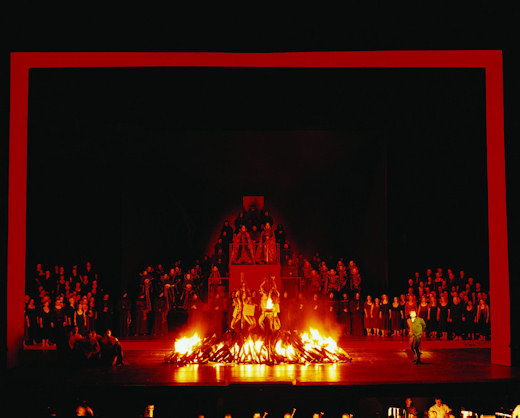Other Links
Editorial Board
- Editor - Bill Kenny
Assistant Webmaster -Stan Metzger - Founder - Len Mullenger
Google Site Search
SEEN AND HEARD
INTERNATIONAL OPERA REVIEW Münchner Opernfestspiele 2010 -
Verdi, Don Carlo: Soloists, Bayerisches Staatsorchester. Chor und Extrachor der Bayerischen Staatsoper. Conductor: Marco Armiliato. Nationaltheater.22. 7.2010. (JMI) Sets, Costumes and Lighting Design: Jürgen Rose. Lighting: Michael Bauer. Elisabetta: Olga Guryakova. Philippo II: René Pape. Rodrigo: Thomas Hampson. Eboli: Nadia Krasteva. L’Inquisitore: Paata Burchuladze. Il Frate: Christian Van Horn. Tebado, Elisabetta’s Page: Lana Kos Lerma: Francesco Petrozzi. Herald: Kenneth Robertson. Heaven’s voice: Elena Tsallagova. Flemish Deputies: Todd Boyce, Nikolay Borchev, Levente Molnar, Christian Rieger, Christoph Stephinger and Rüdiger Trebes.
I first attended this Don Carlo in the Italian five act version in Munich four years ago. At that time, the thought came to my mind while leaving the theatre, that Verdi was quite right to shorten the score by deleting the Fontainebleau act, which adds nothing musically and unnecessarily prolongs the duration of the opera. It would make a change, I thought, to have it in the original French version as was done in Vienna and Barcelona a few years back.
Production: Munich’s Bayerische Staatsoper.
Director (Original): Jürgen Rose. (Revival): Franziska Severin.
Cast:
Don Carlo: Ramón Vargas.

Having the opportunity to see this Jürgen Rose production once more has made me less negative toward it. Possibly I am now more used to minimalist productions than I then was, and I am starting to accept this concept as normal. In this case, there was one single set, with a huge crucifix, which only changed for the Auto da Fe. The stage always had two bare walls and a ceiling, something which helped the projection of voices. If it was shown completely closed, we had the prison and Fontainebleau, if a bed was added, we had Philippo's bedroom. If the doors were opened and there was some light, we had the stage for the veil song. If a trapdoor was introduced with a few ladders, we had San Giusto. As I said, it only changed in a major way for the Auto Da Fe, with the chorus at the back of the stage watching a kind of Holy Week procession of more than dubious taste. Finally we had the naked heretics at the stake.
After his disappointing Tosca, we had Marco Armiliato again on the podium and this time things were much better. Armiliato's conducting had the required strength and tension that was lacking in Tosca and he proved that, in addition to his excellence in accompanying singers, he is a remarkable conductor. He included the original music that puts an end to the prison scene with the entry of Philip II, who sings the Lacrimosa we also hear in Verdi’s Requiem. The orchestra was much better than on previous days and there was a superb Chorus on stage.
In the cast there was a clear imbalance between male and female voices which was quite marked. Starting with the best, I must say that two artists were wonderful - René Pape and Thomas Hampson. I was very keen to see René Pape in this character and he didn’t leave any doubts regarding his suitability for this role. In the current impoverished panorama of bass voices, René Pape today is the best possible Philip. Always powerful, with a very prominent stage presence, he gave a great interpretation.
I had never before attended a performance of Don Carlo where Posa becomes, by his own merits, the true protagonist of the opera. Thomas Hampson was an outstanding interpreter from beginning to end. His magnetism on stage is irresistible and all eyes were focused on him. His performance was significantly different from the one I saw here four years ago, having now become a Rodrigo of exceptional authority and nobility. With artists like Hampson one realizes that there are characters in opera who gain an unexpected importance. Furthermore, his breath control was truly exceptional.
Ramón Vargas was a credible Don Carlo, vocally rather at the limit of his capacities. This good Mexican tenor has a most beautiful voice in the middle register, but his top narrows considerably, which prevents him from shining in the more heroic moments. He was most convincing in the second part of the opera, once past the Auto Da Fe.
The Russian Olga Guryakova was not a convincing Elisabetta, at least in vocal terms. Hers is a big voice, not really suited to Verdi as she sings forte or fortissimo all the time and has terrible Italian diction, seeming not to pronounce the consonants. Bulgarian mezzo Nadia Krasteva was not too persuasive either as Eboli, her voice showing some artificial and open sounds, a lot of decibels and with screamed top notes. The worst thing about this is that there are not many alternatives who can play this role any better.
Paata Burchuladze repeated his Grand Inquisitor, always threatening and thunderous. His vibrato is more than worrying, but he continues to give a most credible portrayal. The secondary roles were very well cast and the group of Flemish Deputies were a luxurious group of singers.
There was a full house once again. Thomas Hampson and René Pape were received in triumph. Ramón Vargas and Nadia Krasteva were greatly appreciated by the audience, but Olga Guryakova was less warmly applauded. This time Marco Armiliato received a unanimous and well deserved ovation.
José M Irurzun
Picture ©
Bayerische Staatsoper / Wilfried Hösl
